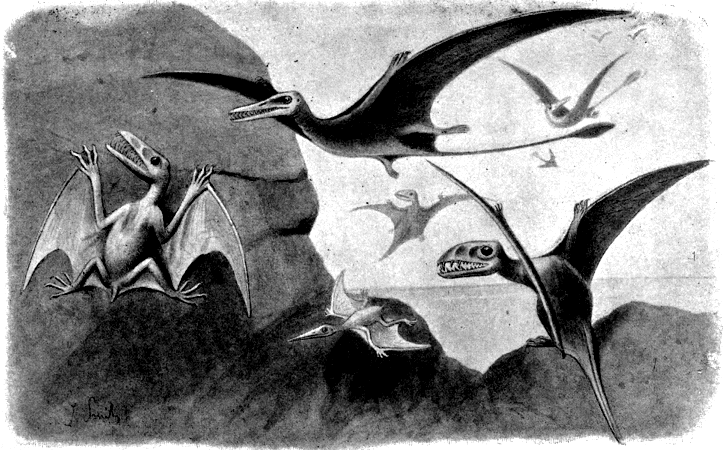Antediluvian Encounters: How Early Humans Triumphed Over Prehistoric Beasts
The following article, originally published in the Evening Star on September 6, 1908, offers a fascinating glimpse into early 20th-century perspectives on human prehistory.1 Drawing from discoveries like the Dryopithecus fossils in Java and the Nampa image in Idaho, the piece speculates on how early humans coexisted with colossal creatures like giant saurians and the Mylodon. It paints a vivid picture of humanity’s budding intelligence and resilience, allowing our ancestors to outwit and outlast the monstrous fauna of the Cainozoic and Tertiary eras. While some claims reflect the scientific understanding—or imagination—of the time, the article captures a sense of wonder about humanity’s place in the prehistoric world. Below is a full transcript of this historic piece, preserved as a window into both the past and the enduring curiosity about our origins.
PREHISTORIC GAME.
Monsters With Which Antediluvian Man Contended.
From the London Telegraph.
The remains of the Dryopitheous or fossil man discovered on the banks of the Bengawan river, in Java, mixed as they were with fossil bones of reptiles, of the Cainozoic age, and lying in the cretaceous strata, clearly prove that man was contemporary with the later of the giant Saurians. Moreover, the discovery of the Nampa image, a piece of handiwork found in the cretaceous strata in Ada county, Idaho, would imply that he had attained some slight degree of art. Assuming then that man was living in the Calnozoic age, the question is, How did he survive his acquaintanceship with the gigantic Saurians, any one of which could plow his way through a suburban street today or trample a herd of elephants to death? How did he escape the shining horns of the Tricertops (Sic) and Ceratosaurus (Sic) or Plesiosaurus? The answer to these questions is that even then man possessed intelligence far in excess of that of the other animals. He could supply his lack of natural weapons by means of sharpened rocks and flints, and could, by reason of his greater courage, take refuge on the sides of volcanoes and other dangerous places where his gigantic foes dare not follow him. At any rate he not only survived the huge creatures of the later reptilian era, but passed into the Tertiary era or Mammalian stage as the first and greatest of the Mammals.
The animals which flourished in the Tertiary era were neither so large nor so ferocious as those of the preceding age. The greatest of them was the Mylodon or giant Sloth, which measured twenty-five feet in height, weighed fifteen tons, and was possessed of such gigantic strength that it could easily pull down a big tree and quietly chew off its foliage. There is a magnificent plaster cast of the skeleton of one of the smaller species of these giant animals (the Megatherium) in the National History Gallery of the British Museum. It is over eighteen feet in height, and it would take three or four men to lift some of the bones. There is a special interest attached to the giant Sloth inasmuch as many Paleontologists believe that there are living specimens of this animal roaming about the practically unknown territory of Patagonia. Indeed, some years ago an expedition under Mr. Hesketh Pritchard, the novelist, set out to capture and bring back a live Mylodon. The project was undertaken on account of the description given by Dr. Moreno, of the La Plata Museum, of a Mylodon’s skin which he found hanging inside a cave in an unexplored portion of the Patagonian hinterland. The expedition was, unfortunately, not successful, so that visitors to the zoological gardens may have to wait some time before they are gratified with a glance of this grim survivor of a long dead past. Stranger even than the story of the living Mylodon is that which has just come from Los Angeles of living dragons or Pterodactyls, one of which was recently seen by two Scotch gentlemen in a cave in the Santa Monica mountains in Malibu.

Man was better able to deal with the animals of the Tertiary era than with those of the Mesozoiac (Sic) era. Tough as were the hides of the giant Sloth, the Mastodon, the Macherodus or saber-toothed tiger and the Sivatherium (giant elk), they could not withstand the sharpened end of a flint driven by the hand of our six-foot-high long-armed, pre-historic ancestor. Despite his smallness, man was still the lord of creation. His brain, crude and undeveloped though it was, proved more than a match for the mere brute force of the lower animals, and already he was laying the foundation of his supremacy in the animal world. Even while the Saurians were rolling through the muddy marshes which formed the site of London and the hairy mammoth and two-tusked rhinoceros made the primeval forests echo with their bellowing, man had begun his weary climb up the hill of evolution, on the summit of which he now so proudly stands.
“Prehistoric Game,” Evening Star (Washington, D.C.), September 6, 1908, Chronicling America: Historic American Newspapers, Library of Congress, https://chroniclingamerica.loc.gov/lccn/sn83045462/1908-09-06/ed-1/seq-73/.





